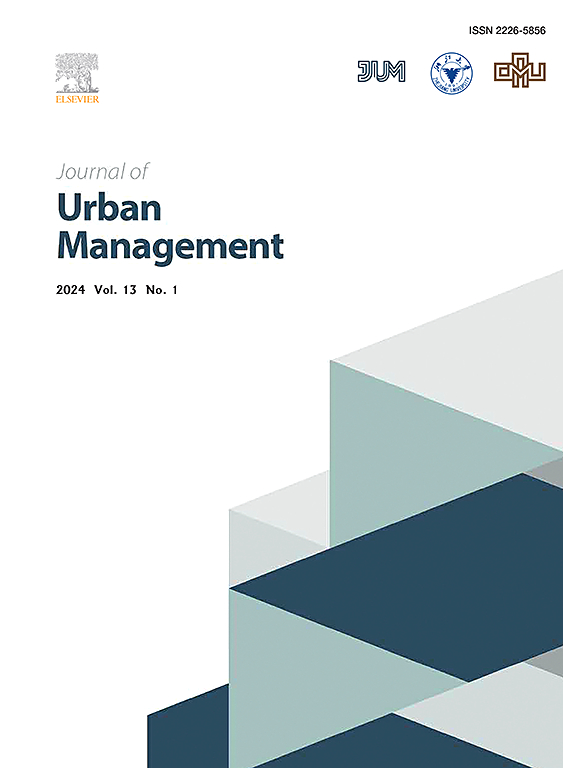Comprehensive geospatial analysis of urban expansion dynamic in Lahore, Pakistan (1998–2023)
IF 5
2区 社会学
Q1 URBAN STUDIES
引用次数: 0
Abstract
Lahore, a UNESCO city in Pakistan, is projected to rise from the sixth to the third fastest-growing city worldwide by 2030. This rapid urbanization challenges its commitment to cultural and ecological preservation, positioning it as an international case study in urbanization research. Thus, the Lahore Development Authority emphasizes the need for ongoing monitoring of urban dynamics to support effective planning and achieve sustainability targets, including Sustainable Development Goal 11. To contribute, we used high-resolution Landsat imagery to analyze the spatial diverging patterns of urban extent from 1998 to 2023 in Lahore. Additionally, we employed a Cellular Automata (CA) Markov Chain model to project urban growth over the next 25 years. As of 2023, we estimated that approximately 53.6% (92,660.9 ha) of Lahore is urbanized, while 46.4% remains unaffected by urban activities. Projections for 2048 suggest that the urban footprint may expand to 75.8% (131,031.5 ha), leaving only 24.2% of the area free from urbanization. Our analysis also revealed divergent urban expansion patterns significantly impacting local ecosystems. It showed a 31% reduction in inland water bodies, a 39.8% loss of vegetation, and a 60.1% decrease in sparse areas, all attributable to urban development. As natural landscapes are replaced by built environments, Lahore is likely facing increasing challenges that could jeopardize the city's green growth and urban ecological balance. Therefore, we urge land use managers, urban planners, and stakeholders in Pakistan to promote initiatives that enhance urban resilience, particularly through smart city planning and creating green and blue spaces. By focusing on Lahore, this study also provides valuable insights that can serve as a benchmark for other rapidly urbanizing cities facing similar challenges.
巴基斯坦拉合尔城市扩展动态的综合地理空间分析(1998-2023)
巴基斯坦的联合国教科文组织城市拉合尔预计到2030年将从全球增长最快的第六位上升到第三位。这种快速的城市化挑战了其对文化和生态保护的承诺,将其定位为城市化研究的国际案例研究。因此,拉合尔发展局强调需要持续监测城市动态,以支持有效规划和实现可持续发展目标,包括可持续发展目标11。利用高分辨率Landsat影像分析了1998 - 2023年拉合尔城市范围的空间分异格局。此外,我们采用元胞自动机(CA)马尔可夫链模型来预测未来25年的城市增长。截至2023年,我们估计拉合尔约53.6%(92660.9公顷)的土地已城市化,46.4%仍未受到城市活动的影响。对2048年的预测表明,城市足迹可能会扩大到75.8%(131,031.5公顷),只剩下24.2%的地区没有城市化。我们的分析还揭示了不同的城市扩张模式对当地生态系统的显著影响。内陆水体减少31%,植被减少39.8%,稀疏地区减少60.1%,均归因于城市发展。随着自然景观被建筑环境所取代,拉合尔可能面临越来越多的挑战,这些挑战可能危及城市的绿色增长和城市生态平衡。因此,我们敦促巴基斯坦的土地利用管理者、城市规划者和利益攸关方推动增强城市韧性的举措,特别是通过智慧城市规划和创造绿色和蓝色空间。通过关注拉合尔,本研究还提供了有价值的见解,可以作为其他面临类似挑战的快速城市化城市的基准。
本文章由计算机程序翻译,如有差异,请以英文原文为准。
求助全文
约1分钟内获得全文
求助全文
来源期刊

Journal of Urban Management
URBAN STUDIES-
CiteScore
9.50
自引率
4.90%
发文量
45
审稿时长
65 days
期刊介绍:
Journal of Urban Management (JUM) is the Official Journal of Zhejiang University and the Chinese Association of Urban Management, an international, peer-reviewed open access journal covering planning, administering, regulating, and governing urban complexity.
JUM has its two-fold aims set to integrate the studies across fields in urban planning and management, as well as to provide a more holistic perspective on problem solving.
1) Explore innovative management skills for taming thorny problems that arise with global urbanization
2) Provide a platform to deal with urban affairs whose solutions must be looked at from an interdisciplinary perspective.
 求助内容:
求助内容: 应助结果提醒方式:
应助结果提醒方式:


